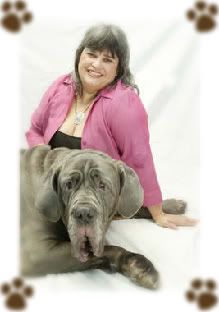I was up in the woods today walking with Bailey & Sticky. It was lovely – we almost had the place to ourselves for a couple of hours!
We met up with a few owner dog partnerships though; some who had their dogs on lead, so I of course got mine back and held them to me quietly as they passed by, and some with offlead dogs who I assumed were offlead because they don’t present a problem in public areas.
We were walking towards a pair of Weimaraners who were offlead with their owner. As we approached one of them came forward to approach us. Sticky did the same thing but then hesitated. He had sensed something not right. He paused, gave some very clear ‘cut off’ signalling to the other dog/s and looked back at me. I smiled at him and said ‘Good boy Sticks’ to reinforce his peaceful actions instead of flying upto them out of control.
As we got closer he approached the Weimaraner pair and everything seemed pretty okay; lots of mutual bottom sniffing and wheeling around each other. Sticks then pottered off peacefully. By this time Bailey and I had caught up. I always hold her collar quietly and accompany her up to other dogs just so that she approaches gently and doesn’t alarm them by running upto them.
I then became aware of why Sticky had paused. The male Weimaraner was in an extreme state of arousal. His pupils were almost fully dilated, his hackles were up all the way along his neck to the base of his tail, his movements were stiff and deliberate and his general behaviour was far from relaxed and friendly.
Instead of calmly scenting Bailey, he immediately launched himself onto her shoulders, pushing her down. She responded by playbowing and jumping to appease him as she could obviously sense his ‘tone’ too. Far from appeasing and encouraging to play, he became even more agitated, trying to stand over her, shoulder-barge her and pounding on her shoulders and neck again and again. I then realised that the owner was not going to step in so calmly stood between them, helping poor Bailey out and providing a barrier for her as she had become stressed by this wildly inappropriate behaviour. The owner then said ‘oh he does this – I have to be careful with him’, grabbed him and pulled him away.
I said nothing more and simply trotted on with Bailey, wanting to help her recover quickly from this ‘thug-mugging’, which she did within a few minutes.
I have no doubt that that the Weimaraner was ‘spoiling for a fight’ and if Bailey hadn’t behaved in such an overtly appeasing manner, he would have picked one. I know many dogs who would have objected to his thuggish behaviour with a growl or stiffness, and this Weimaraner would have over-reacted because he was already in a state of hyper-arousal. Who knows why? Maybe he was never socialised properly as a pup, maybe he was attacked by another thug when he was younger, maybe he is fed a high-protein ‘working dog’ food… Who knows?
The owner knows… that’s who.
She KNOWS there was a problem with this dog’s reaction to other dogs but instead of dealing with this situation promptly, calmly and with some authority, she allowed him to continue his mugging uninterrupted until I stepped in. She KNOWS there is a problem with this dog but allows him offlead around others.
It’s this kind of owner that gives the rest of us a bad name; someone that KNOWS deep down there is a problem but is in denial, allowing their dog to practice their behaviour unchecked and without getting any kind of help. It is the dog I feel sorry for. One day it is going to mug the wrong dog, end up seriously hurt and it will be his owner, the one who should be guiding him and leading him through life, who must carry the blame – but she won’t. She will blame the owner of the other dog. Scary, isn’t it?







